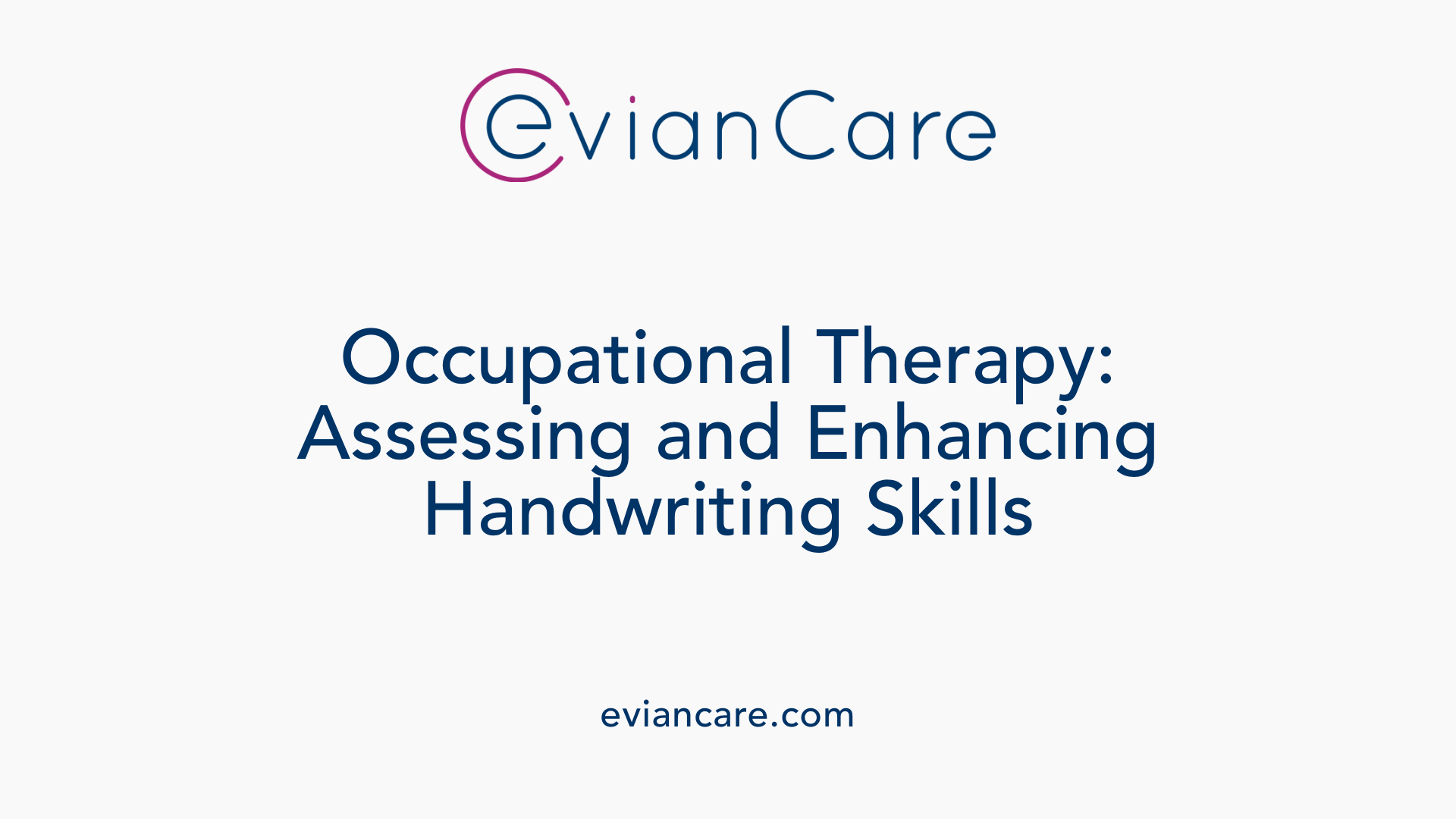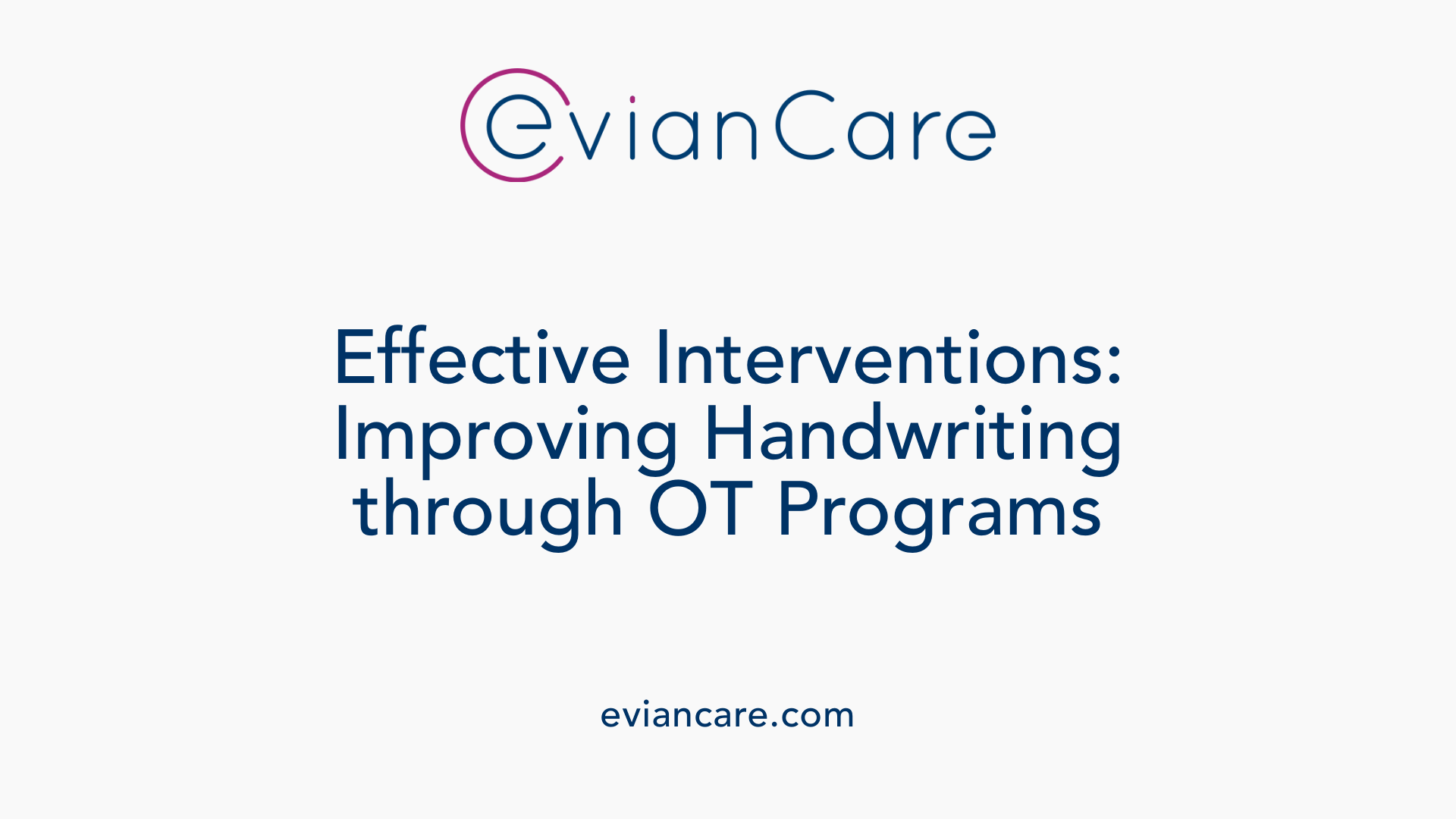
The Crucial Role of OT in Developing Handwriting Skills
Handwriting is a fundamental skill that supports academic achievement, cognitive development, and self-esteem in children. Occupational therapy (OT) plays a pivotal role in fostering handwriting readiness by addressing underlying motor, sensory, and perceptual challenges. Early intervention, comprehensive assessments, and targeted strategies enable children to develop legible, fluent handwriting, setting a strong foundation for future academic and social success.
Understanding Handwriting Readiness and Its Developmental Foundations

What developmental factors and stages are related to handwriting readiness in children?
Handwriting readiness depends on a range of developmental skills that children develop over time. Core factors include fine motor control, hand strength, visual-motor integration, and pre-writing abilities. These foundational skills enable children to control pencil movements, form letters, and write clearly.
Children usually progress through several stages in developing handwriting skills. Early on, between ages 1-2, they begin with scribbling. This stage involves uncontrolled, spontaneous marks that are the precursor to more intentional drawings.
By ages 2-3, children start controlling their drawings better and copying simple shapes, such as circles and lines. These shapes are essential building blocks for letter formation.
Between ages 3-6, children advance to copying letters, numbers, and basic words, developing upper and lowercase letter skills along with spacing and alignment. During this period, they also refine their grasp patterns and wrist stability.
In addition to motor skills, cognitive and perceptual skills are crucial. Understanding spatial concepts like 'next to' or 'above,' along with visual perception, impacts their ability to write within designated spaces and copy accurately.
Hand dominance and visual perception maturation further support the ability to coordinate eye and hand movements smoothly.
Mastering these stages and skills allows children to develop legible, efficient handwriting, which is essential for academic success. Early assessment and targeted interventions during these stages can significantly improve outcomes for children experiencing difficulties.
Why is early intervention important in developing handwriting skills in children?
Implementing support early in a child's development is vital for preventing ongoing handwriting issues. Early intervention addresses underlying perceptual, motor, and cognitive challenges before they become ingrained.
Research shows that curriculum-based programs focusing on visual-motor skills and fine motor practice are more effective when introduced at a young age. These programs help improve handwriting legibility and speed, laying a foundation for future literacy.
Early support also supports the development of reading skills since handwriting practice activates brain areas involved in letter recognition and reading. Improving these skills early can promote better academic performance overall.
Furthermore, early intervention helps protect a child's self-esteem by reducing frustration caused by messy or slow handwriting. When children acquire automaticity and confidence early on, they are more motivated to participate and succeed.
Overall, timely support ensures children develop strong, legible handwriting skills that contribute to their academic progress and lifelong learning success. It provides them with the tools needed for effective communication and confidence in their education journey.
The Role of Occupational Therapy in Supporting Handwriting Readiness

How do occupational therapists assess handwriting readiness in children?
Occupational therapists play a vital role in evaluating a child's ability to write independently and legibly. They utilize comprehensive assessment methods that look into various developmental, motor, sensory, and perceptual skills.
Therapists conduct clinical observations and employ standardized tools such as the Print Tool, ETCH, Minnesota Handwriting Assessment, and THS-R to measure handwriting proficiency. These assessments evaluate different elements including letter size, spacing, alignment, and overall legibility.
In addition to handwriting specific tests, therapists assess underlying motor components like hand strength, finger dexterity, pencil grasp, and postural control. Visual-motor integration is also evaluated using tools like the Beery VMI or the BOT-2. Sensory processing and motor planning skills are reviewed to understand how these areas influence handwriting performance.
A child's medical and developmental history provides further insight into factors affecting handwriting. Altogether, these assessments help therapists pinpoint areas in need of targeted intervention, ensuring a personalized approach to improving handwriting skills.
What are effective occupational therapy interventions for improving handwriting skills?
Interventions tailored by occupational therapists focus on underlying challenges such as motor control, sensory processing, and postural stability.
Common activities include fine motor exercises like threading beads, using clothespins, and manipulating playdough to enhance hand strength and dexterity. Sensory integration techniques, such as swinging or deep pressure activities, help children focus better during handwriting tasks.
Therapists also teach proper pencil grasp and ergonomic positioning—ensuring children sit with feet flat on the floor and hold their pencil correctly. Core strength activities, like yoga poses, animal walks, or wheelbarrow walks, support postural stability.
Visual-motor activities, such as copying shapes, tracing, and completing mazes, improve eye-hand coordination. These interventions are designed to be engaging and adapted to each child's unique needs, aiming to build confidence and proficiency gradually.
What techniques and strategies are used in occupational therapy to improve children's handwriting skills?
Occupational therapists employ a range of strategies grounded in evidence-based practices to enhance handwriting. Explicit instruction involves demonstrating correct letter formation, guiding children through tracing, copying, and spelling activities.
Multi-sensory approaches—using materials like salt trays, textured letters, and colorful markers—make learning more engaging and reinforce motor memory.
Consistent practice with feedback helps children internalize proper letter shapes and spacing. Incorporating games and playful activities increases motivation; for example, involving finger paints, salt writing, or digital apps like Dexteria or TouchMe UnColor.
Therapists also focus on building foundational skills such as hand strength, finger control, and visual perception independently, but emphasize integrating these skills directly into handwriting tasks whenever possible.
Targeted interventions should ideally combine modeling, guided practice, and self-monitoring strategies to foster independence and improve handwriting quality.
In summary, occupational therapy uses a holistic, fun, and systematic approach, supported by research, to support children in developing legible, fluent handwriting. Early assessment, personalized activities, and engaging practice are pivotal to success in overcoming handwriting difficulties.
Practical Strategies and Activities in Occupational Therapy to Support Handwriting Development
What techniques and strategies are used in occupational therapy to improve children's handwriting skills?
Occupational therapy employs a variety of techniques to enhance children's handwriting abilities. Central to these strategies is explicit instruction, which involves modeling proper letter formation, guided practice, and the integration of multisensory activities. For example, therapists often incorporate tracing, drawing, and copying tasks that are meaningful and variable to promote motor learning. Evidence supports that these practice methods, aligned with principles of motor learning, can significantly improve handwriting legibility.
Foundational components such as hand strength, dexterity, and visual-motor integration are also targeted, although research indicates that practicing handwriting itself tends to be more effective than focusing solely on underlying skills. Cognitive approaches—like encouraging self-evaluation, peer feedback, and mnemonic devices—assist children in internalizing correct letter formation. A combined approach blending explicit, multisensory instruction with cognitive strategies fosters better handwriting skills in children.
What are some activities used to develop pre-writing skills and hand strength?
Building pre-writing skills and hand strength involves engaging children in fun, purposeful activities. These include threading and lacing activities to develop bilateral hand coordination, Play-Doh manipulations to strengthen finger muscles, and cutting projects that refine spatial awareness.
Using tongs or squeezers helps improve pincer grasp, while drawing on vertical surfaces encourages proper wrist and arm movement. Opening containers and practicing pre-writing shapes—such as lines, circles, crosses, squares, diagonals, and triangles—lay a foundational skill set. Finger games, crafts, and construction toys foster fine motor control and precision.
Sensory-rich activities play a vital role, such as finger painting, tracing in sand, or drawing with salt or rice. These tactile and proprioceptive inputs enhance motor planning, coordination, and sensory processing.
To support overall postural stability essential for handwriting, therapists recommend movement and core-strengthening exercises. Activities like yoga poses, animal walks, wheelbarrow walks, and balance exercises help develop the necessary trunk and upper body stability, making handwriting tasks less tiring and more controlled.
Implementing multisensory approaches
Multisensory strategies are effective in reinforcing handwriting skills. Children can learn letter shapes and improve motor skills through visual, tactile, kinesthetic, and auditory activities.
Examples include:
- Using textured letters made of foam or sandpaper for tactile feedback.
- Coloring or painting with finger paints and Wikki Stix to combine visual and tactile input.
- Movement activities like jumping, swinging, or using balance beams to integrate vestibular and proprioceptive systems.
- Visual-perceptual tools, such as tracing apps or mazeworks, to enhance eye-hand coordination.
Incorporating these approaches creates engaging, varied learning experiences that motivate children and support neural pathways involved in handwriting. Integrating movement, sensory input, and cognitively rich activities provides a comprehensive method to develop the skills necessary for legible, fluent handwriting.
Environmental and Classroom Strategies for Handwriting Support

What signs indicate a child may need occupational therapy intervention for handwriting difficulties?
Signs that a child may require occupational therapy (OT) focus primarily on persistent challenges with handwriting quality and effort. These include consistently poor letter formation, uneven spacing between words and letters, and frequent reversals or mirror writing. Children whose handwriting seems illegible or who struggle to stay within lines and margins may also be experiencing underlying issues.
Beyond legibility, physical signs such as hand fatigue, crayon breaking, or avoiding handwriting tasks altogether can signal sensory or fine motor problems. Difficulties with grasping a pencil correctly, controlling the pressure exerted on paper, or coordinating eye and hand movements are other indicators. If children display delays in developing prewriting skills—such as copying basic shapes or following patterns—or become frustrated and lose motivation during writing activities, these are additional cues that occupational therapy assessment might be necessary.
Early recognition of these signs allows targeted intervention, which can include exercises to strengthen fine motor muscles, improve sensory processing, and develop better visual-motor integration, all essential for writing success.
The Impact of Curriculum-Based and Targeted Interventions in Handwriting Development

What are the effects of occupational therapy programs and interventions on handwriting skills?
Research indicates that curriculum-based handwriting programs, such as Write Start and Handwriting Without Tears, can produce measurable improvements in children's handwriting abilities. These evidence-supported interventions typically lead to small to medium increases in handwriting legibility, which is a common challenge among young learners.
While these programs significantly enhance how well children form letters and words, their impact on writing speed and fluency remains mixed, with some studies showing benefits and others reporting limited effects. Despite the varied results, early and tailored intervention strategies are vital for children experiencing difficulties.
Effective integration of these programs within school settings, complemented by consistent practice at home, tends to optimize outcomes. A growing body of research emphasizes the importance of multisensory and movement-based strategies that assist children in developing automatic letter formation, proper spacing, and overall handwriting quality. Ongoing research continues to refine these approaches, aiming for comprehensive solutions that support both legibility and writing efficiency.
How do occupational therapists incorporate research into their practice to support handwriting?
Occupational therapists employ evidence-based practices by choosing curriculum-aligned programs like Write Start and Handwriting Without Tears, which are supported by research. They integrate multisensory activities—such as tactile, visual, and movement exercises—that target underlying skills essential for good handwriting, including strength, visual perception, and motor planning.
Thorough assessments inform therapists about each child's unique needs, enabling them to adapt interventions effectively. Collaboration with teachers and parents is a hallmark of effective practice, ensuring consistent reinforcement of strategies and facilitating progress monitoring.
Therapists utilize standardized assessments to track improvements in handwriting skills, adjusting therapy plans as necessary. Their reliance on current research ensures that interventions not only improve legibility and accuracy but also bolster a child's confidence and motivation in written expression. By continuously integrating new findings, occupational therapists contribute to creating personalized, developmentally appropriate interventions that foster long-term success in handwriting.
Supporting Children’s Handwriting for Lifelong Success
Occupational therapy offers a comprehensive approach to supporting children’s handwriting readiness by assessing foundational skills, implementing effective interventions, and integrating strategies into everyday environments. Early diagnosis and targeted therapy can dramatically improve handwriting legibility, speed, and confidence, reducing the risk of academic difficulties and fostering positive self-esteem. Collaboration among parents, teachers, and therapists ensures consistent support tailored to each child’s unique needs, which is vital for fostering lifelong writing skills and academic achievement. As research continues to evolve, the integration of evidence-based programs and multisensory approaches will further enhance the effectiveness of occupational therapy, ensuring all children have the opportunity to develop functional, legible handwriting that supports their educational journey and beyond.
References
- Activities to Improve Handwriting - The OT Toolbox
- Handwriting Readiness Groups - AbilityPath
- Writing Readiness (Pre-Writing) Skills - Kid Sense Child Development
- Curriculum-Based Handwriting Programs: A Systematic Review With ...
- Occupational Therapy Tips for Handwriting - Lurie Children's
- Tips from an OT for Developing Handwriting At Home
- Effectiveness of a Handwriting Readiness Program in Head Start
- Addressing Handwriting Challenges in School-Aged Children












